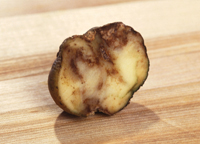
The 2009 season was a bad year in North America for Phytophthora infestans, more commonly known as late blight.
The 2009 season was a bad year in North America for Phytophthora infestans, more commonly known as late blight.
 |
| An example of a tuber infected with late blight. The disease only survives in living potato tissue. Advertisement
|
“We haven’t had an outbreak of this severity since 1994,” said Gary Secor during the 2010 Manitoba Potato Production Days held recently at the Keystone Centre in Brandon, Man.
Secor, a professor of plant pathology at North Dakota State University, reported that the source this past year was a load of infected tomatoes shipped from an Alabama grower to big box stores up and down the east coast.
“The wet summer weather made for perfect conditions for the rapid spread of late blight throughout the eastern United States and to the mid-West,” he said. “There were isolated cases also found in the Dakotas and Manitoba.”
He noted that some of the blight found last year was of an unknown or new genotype, which may have been a new strain from Mexico or the result of a genetic mutation.
Rick Peters, an Agriculture and Agri-Food Canada (AAFC) research scientist based in P.E.I., noted that he has been studying the condition since the early 1990s.
“Back then,” he said, “there was only one strain and that was sensitive to Ridomil. A series of hurricanes along the east coast in 1994 introduced a series of new strains. In Manitoba, A1, US6 and US11 have been found. A2 is predominant in other provinces while US8 is the most common in Quebec and the eastern U.S.”
Phytophthora infestans used to be considered a fungus but is now recognized as a form of algae, Peters said. The spores can be spread by wind or rain and can be carried for hundreds of miles. They can remain dormant when the weather is hot and dry then quickly come back to life and spread rapidly when cool, wet conditions appear.
Secor added that late blight only survives in living potato tissue. When the host dies, so does the algae – except for the zoospores, a product of the mating of A1 and A2 strains that can survive the winter and cause blight even earlier.
“We haven’t seen any zoospores in Canada yet,” he said. “But the latest epidemic last year in Ontario may be a precursor.”
 |

|
| North Dakota State University plant pathology professor Gary Secor
|
Agriculture and Agri-Food Canada (AAFC) research scientist Rick Peters
Photos by Myron Love
|
The early symptoms of blight, Secor said, resemble pink rot, but pink rot doesn’t go as deeply into the plant. The spores are shaped like lemons. It takes 12 hours for an infection to take hold and five to seven days before the symptoms appear.
One way to prevent the spread of late blight is by eliminating cull piles by covering the infected potatoes with a tarp, burying them or feeding them to livestock, Peters said.
Volunteer potatoes – tubers that are left in the field at harvest – can also serve as hosts for blight and should be treated with herbicides.
During his presentation, Peters reported on trials with Revus and Bravo that his research team conducted at Cavendish Farms in P.E.I.
“Revus applied as a fungicide during the growing season was spectacularly successful at suppressing the spores,” he said. “When we combined Revus and Bravo, we had 100 per cent success at suppressing the US8 and A2 strains of blight.”
He further reported that trials with Confine, a phosphorous acid product, also produced very good results. The chemical, Peters reported, moves throughout the infected plant, attacking the blight organism and stimulating the plant’s natural defences. The product is also environmentally friendly, Peters added.
“Post-harvest application was very successful,” he said. “But the timing is very important. The product has to be applied within six hours of the tuber being harvested before late blight can take hold.
“Confine works especially well when combined with Bravo.”
He noted that Confine looks to be equally effective in combating pink rot and silver scurf.
Secor cautioned that combating late blight is a communal responsibility. “Don’t try to hide it,” he told growers. “You have to tell everyone so everyone can tackle the problem together.”
Secor recommended other fungicides – such as chlorothalonil and mancozeb – for preventing or suppressing late blight.
“It is important that producers become educated about late blight,” he said.
Secor favours applying fungicides on a regular five- to seven- day cycle.
“In 2010, we can expect late blight to make its appearance somewhere,” he warned. “There is not much tuber infection yet, but we need to be ready just in case.”
Print this page